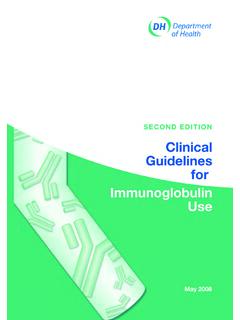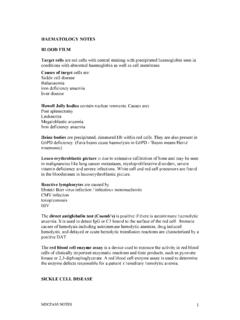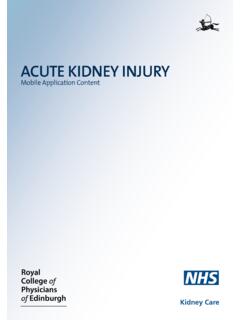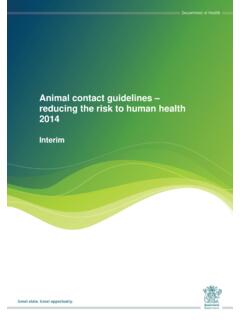Transcription of Managing suspected infectious diarrhoea - GOV.UK
1 1 Managing suspected infectious diarrhoea Quick reference guidance for primary care Withdrawn April 2022 Managing suspected infectious diarrhoea : Quick Reference Guide for Primary Care 2 About Public Health England Public Health England exists to protect and improve the nation's health and wellbeing, and reduce health inequalities. It does this through world-class science, knowledge and intelligence, advocacy, partnerships and the delivery of specialist public health services. PHE is an operationally autonomous executive agency of the Department of Health. Public Health England Wellington House 133-155 Waterloo Road London SE1 8UG Tel: 020 7654 8000 Twitter: @PHE_uk Facebook: Prepared by: Dr Cliodna McNulty For queries relating to this document, please contact: or Crown copyright 2015 You may re-use this information (excluding logos) free of charge in any format or medium, under the terms of the Open Government Licence To view this licence, visit OGL or email Where we have identified any third party copyright information you will need to obtain permission from the copyright holders concerned.
2 Any enquiries regarding this publication should be sent to or Published: January 2015 PHE publications gateway number: 2014526 Withdrawn April 2022 Managing suspected infectious diarrhoea : Quick Reference Guide for Primary Care First Produced 2007 Latest Review November 2014; Next Review: November 2017 3 Contents About Public Health England 2 Contents 2 Foreword aims and adaptations 4 Quick guide and stool sample collection instructions 8 References 9 Acknowledgements 15 Withdrawn April 2022 Managing suspected infectious diarrhoea : Quick Reference Guide for Primary Care First Produced 2007 Latest Review November 2014.
3 Next Review: November 2017 4 Foreword aims and adaptations Audience: primary care prescribers in general practice and out of hours settings including doctors, nurses and pharmacists those providing first point of contact for infections Aims: to provide a simple, effective, economisal and empirical approach to the treatment of infectious diarrhoea to target the use of antibiotics and antifungals in primary care to minimise the emergence of bacterial resistance in the community Implication: the guidance should lead to more appropriate antibiotic use use of this guidance may increase or decrease laboratory workload change in laboratory workload may have financial implications for laboratories and primary care commissioners Production.
4 The templates have been produced in consultation with GPs and specialists in the field they are in agreement with other guidance, including Clinical Knowledge Summaries, the Scottish Intercollegiate Guidelines Network and NICE the guidance is fully referenced and graded the guidance is not all-encompassing as it is meant to be quick reference if more detail is required we suggest referral to the websites and references quoted the guidance is updated every three years or more frequently if there are significant developments in the field Poster presentation of guidance: the summary tables are designed to be printed out as posters to use in the surgery the rationale and evidence is designed to be used as an educational tool for you and your colleagues to share with patients as needed Local adaptation.
5 We would discourage major changes to the guidance but the Word format allows minor changes to suit local service delivery and sampling protocols to create ownership agreement on the guidance locally, dissemination should be taken forward in close collaboration between primary care clinicians, laboratories and secondary care providers This guidance is based on the best available evidence but professional judgement should be used and patients should be involved in the decision. Withdrawn April 2022 Managing suspected infectious diarrhoea : Quick Reference Guide for Primary Care 5 Quick guide and sample collection instructions OVERVIEW B/C Acute diarrhoea is usually defined as: 3 or more episodes a day, <14d and stool takes shape of ,2,3,4,5 B+, 11 C infectious diarrhoea is common (affecting a quarter of us annually7B+) but should be viewed as a differential diagnosis 4 alongside other potential causes of diarrhoea as no infectious agent is found in 60% of diarrhoeal Most infectious diarrhoea is a self-limited, usually viral illness3, 7 B+.
6 Nearly half of episodes last less than one If diarrhoea has stopped, culture is rarely indicated unless there is a public health Do not give empirical antibiotics unless Clostridium difficile13, 16, 27 or Campylobacter are suspected . C WHEN TO SEND a faecal specimen in cases of diarrhoea 6,9, 10,11, 12, 26 C 1. SYMPTOMS/SIGNS OR CLINICAL INDICATIONS Patient systemically unwell needs hospital admission and/or antibiotics OR is , 31 Blood, mucus or pus in stool. 4 In children who have acute painful, or bloody diarrhoea to exclude verotoxigenic infection including O157. 8 12 Recent antibiotics, 27 PPI or hospitalisation (C. difficile).
7 11, 13 diarrhoea after exotic foreign travel (state countries); you should request ova, cysts and parasites (OCP).1,2 Specifically when amoebae, Giardia or cryptosporidium are suspected 21, 29 especially if there is recurrent or prolonged diarrhoea (over 14 days) or travel to at-risk areas. To exclude infectious diarrhoea in the differential diagnosis, eg patient has severe abdominal pain, exacerbations of inflammatory bowel disease or irritable bowel Request virology where a definitive diagnosis is ,26 2. PUBLIC HEALTH INDICATIONS 9,10, 11, 12 suspected food poisoning eg barbecue, restaurant, eggs, chicken, shellfish9 - give details.
8 diarrhoea in high-risk situations for example: food handlers, health or child care workers, children at nurseries or after farm visits (E. coli O157),8 elderly residents in care homes. 9, 10, 11, 12 Contact with other affected individual(s) or outbreaks of diarrhoea in: care home (norovirus), community, family, etc when isolating an organism may help pinpoint cause. 9 Contacts of patients where there may be serious sequelae9 (E. coli 0157 or C. difficile). Close household contacts of Giardia cases. WHAT TO SEND (see next page for patient information on how to collect) Only send loose stools as formed stools will not be examined by the laboratory.
9 To ensure correct tests are performed please include travel destination and reason for sending sample on laboratory request form C B For routine microbiology investigation send a single specimen (a quarter full specimen pot is the minimum needed) If the diarrhoea is post exotic foreign travel, prolonged or recurrent, you should give details and specifically request ova, cysts and parasites (OCP) and send three specimens at least two days apart, 28 B- as OCP are shed intermittently. Withdrawn April 2022 Managing suspected infectious diarrhoea : Quick Reference Guide for Primary Care First Produced 2007 Latest Review November 2014; Next Review: November 2017 6 This evidence-based guidance was developed by the PHE Primary Care Unit in collaboration with Clinical Knowledge Summaries (CKS), GPs, the BIA and other experts.
10 It is in line with PHE SOPs, CKS and SIGN. Interpreting the laboratory report B+ C A bacterial pathogen is found in only 2 5% of specimens ,5,7 OCP reported only if looked for. Salmonella, shigella, clostridium, campylobacter, O157 and cryptosporidium are routinely sought and As viruses, OCPs and other uncommon but potential pathogens are not routinely sought, a negative report does not mean that all infections have been excluded,26 eg there are no routine methods for detecting enterotoxigenic E. coli, the commonest cause of traveller s diarrhoea . Antibiotic management of suspected and proven infectious diarrhoea B A B/C A+ A+ C Antibiotics are not usually recommended for adults with diarrhoea of unknown The lab will happily advise.















